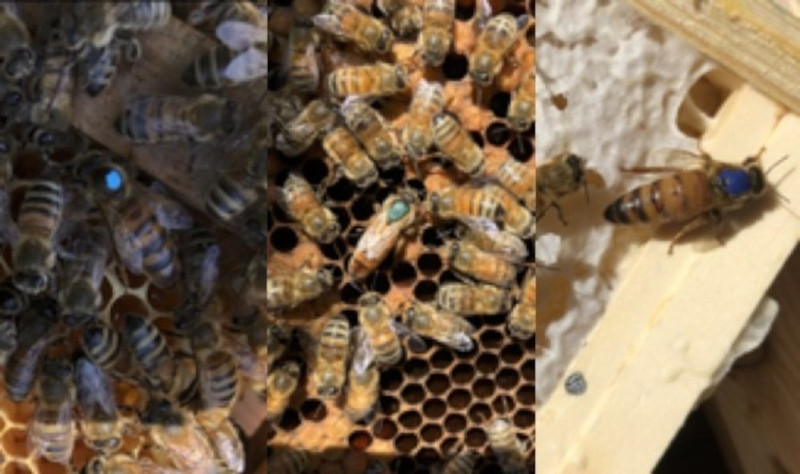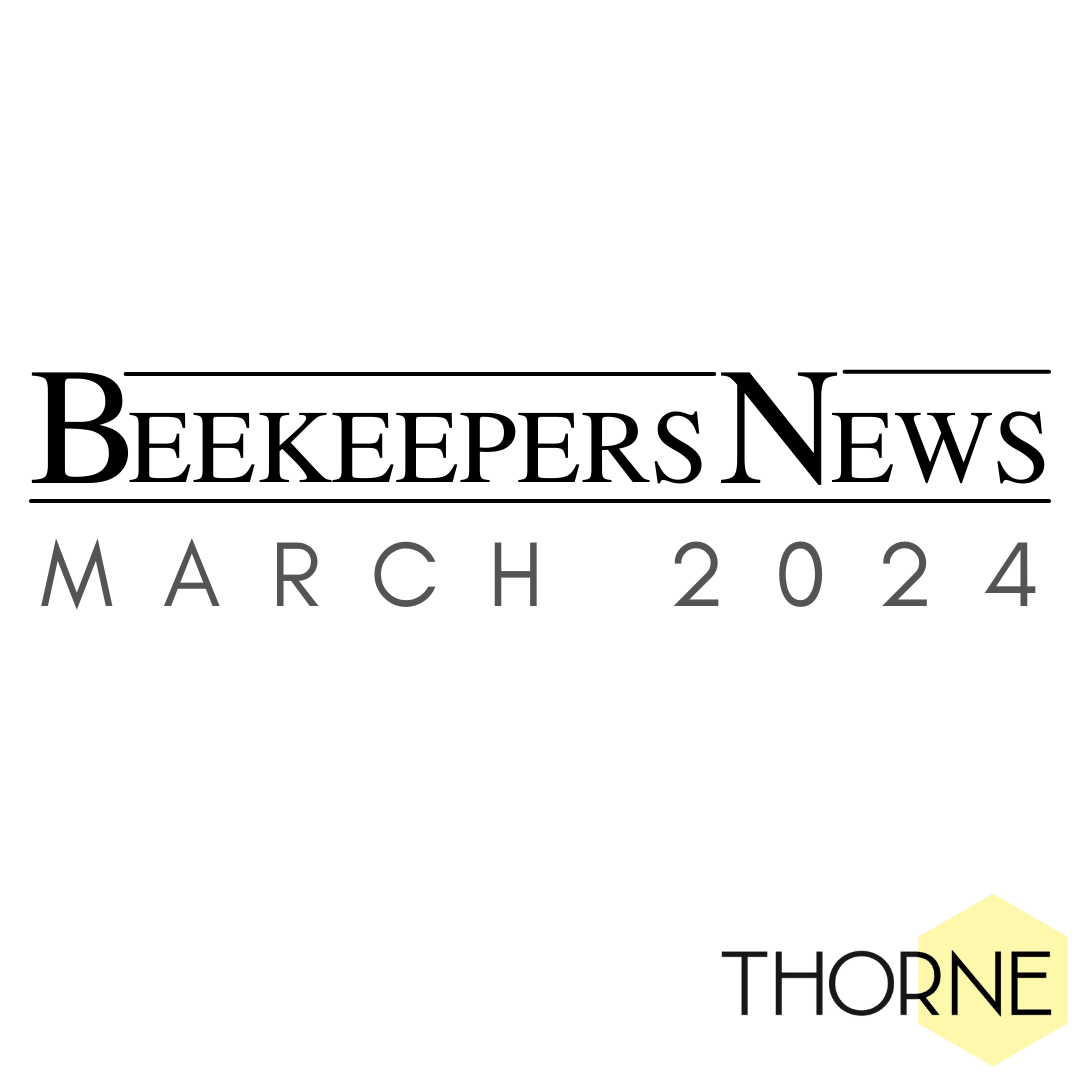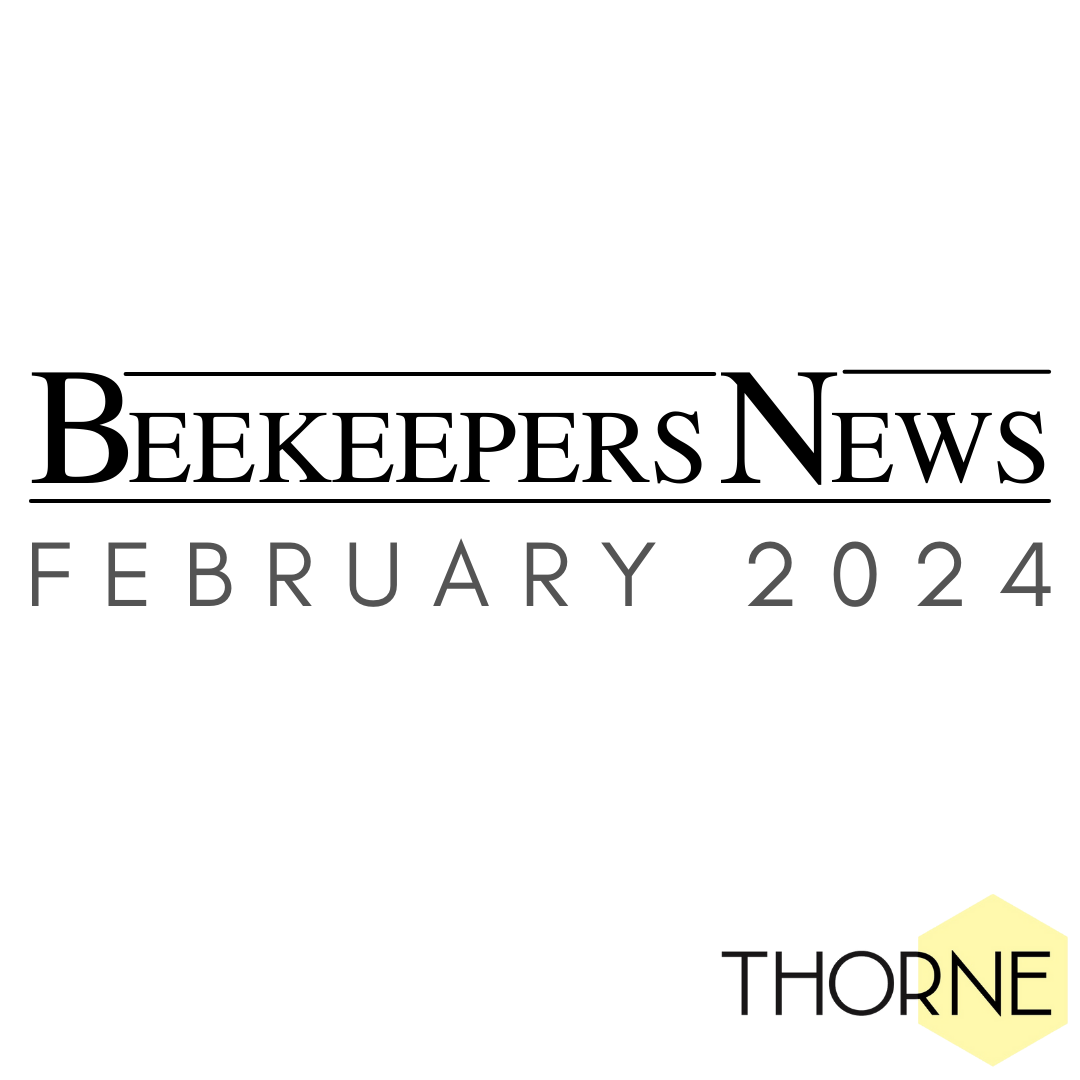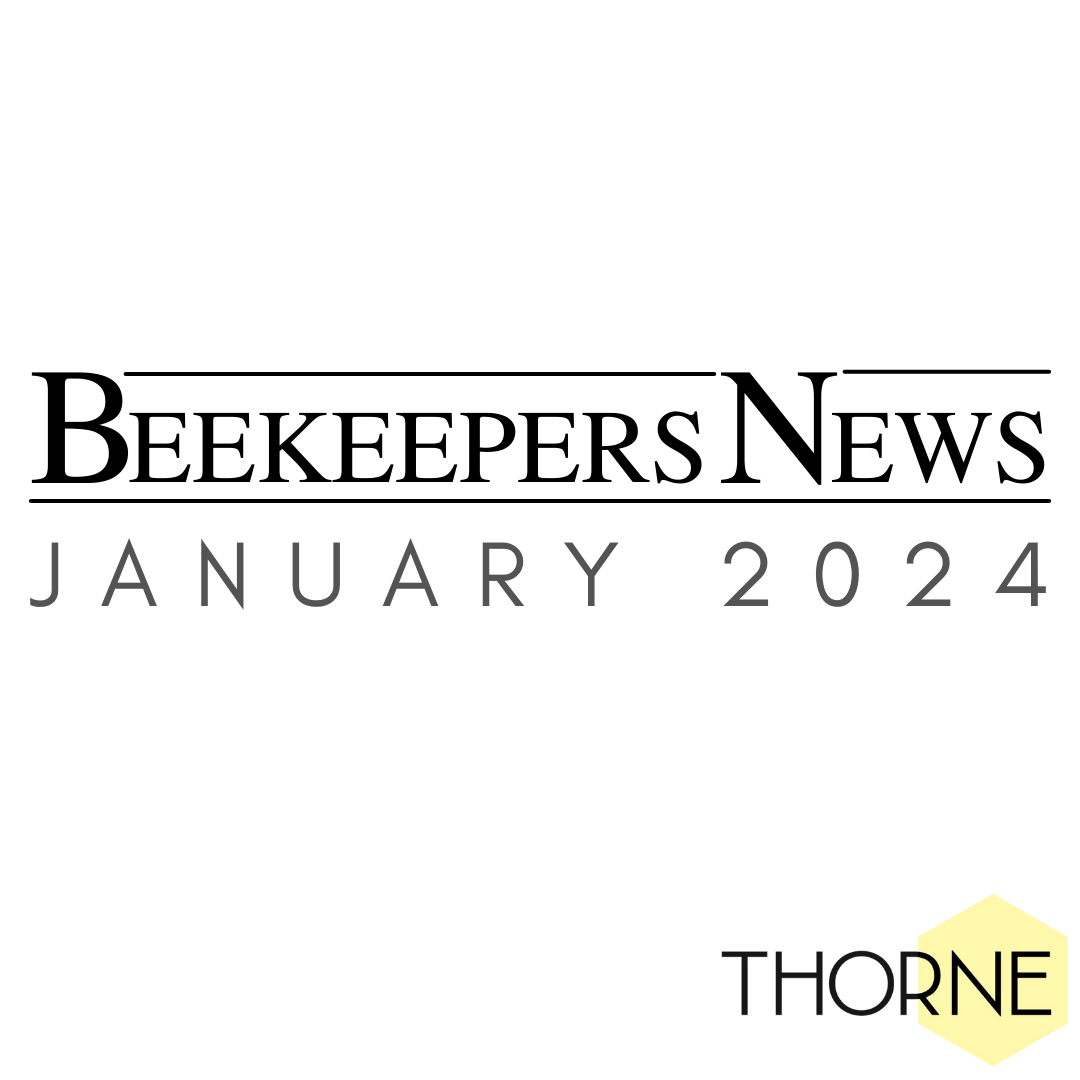July Roundup
Another month gone and we are almost back to normal here at Thorne. Social distancing and cleaning of common touch points seems normal practice. We have also become accustomed to the wearing of face coverings in our shops.
Our Rand, Newburgh and Devon shops are open as usual. Please do come prepared with your masks.
The Windsor shop will re-open from Tuesday 11th August. Face coverings must be worn and only two customers or family groups will be allowed in the shop at one time.
Stockbridge will be open for Click & Collect orders from Tuesday 4th August. Please do order in advance, wait for us to confirm when your order will be available, and then Lin or Chris will have your order ready to collect from outside the Stockbridge branch.
Fancy some honey beer this summer?? We have teamed up with Hiver Beers to offer our customers 10% off the Taste of Summer collection. The collection holds a range of honey beers in bottles, mini kegs and hampers. The code is THORNYBEER15 and is valid until 30th September 2020.

A belated congratulations to our beekeepers Sasha and Simon on the birth of their son Felix in May during the lockdown. I am sure you will agree he is a little cutie!!

Online Sale
We are steadily gearing up for our online and phone sale beginning on 31st August. All our usual bargains will be available. See how we have slashed the price of the frames (2nd quality timber). A selection of prices for both frames and hive parts are listed below. A full list of sale items and prices will be available soon.
- 50 DN1/SN1 - £20
- 50 DN4/SN4/OSB - £24
- 50 14”x12”/DN5/SN5 - £30
- 50 Langstroth/Commercial (all sizes) - £30
- National Super - £13
- National Brood Body - £16
- National 4” Roof - £18
- National Open Mesh Floor with Entrance Block - £14
- Langstroth Brood Body - £18
- Langstroth Super - £14
Maqs
We are delighted to say that MAQS (Mite Away Quick Strips) is now in stock. MAQS is the only licensed varroa control which can be safely used with the honey supers in place. Developed by NOD Apiaries in Canada this easy to use varroa treatment takes only seven days to effectively release the formic acid vapour. Storage and usage instructions must be followed closely. Available in a 2 dose pack for £15 and a 10 dose pack for £55.

Equipment Focus…
This month we are focusing on wasps and what you can do to stop them robbing or even wiping out your colony.
Wasp Out
A very simple device which helps prevent robbing by wasps. Based on an entrance block the wasps struggle to find their way through the side entrances which are blocked with doweling rods. The bees quickly work out the route in and out of the hive. We would recommend using the wasp out in conjunction with a Wasp Bane or traditional wasp traps. Available for National and Langstroth hives for £7.20 and WBC hives for £12.35. We also have a YouTube video showing how to correctly position the Wasp Out. https://youtu.be/3bDr7ebjtII

HyfeGate
We were introduced to the HyfeGate in Apimondia in 2019 and were immediately drawn to both the simplicity of the product and indeed the inventor Kyle Atkinson and his team at BEE-IQ Solutions in New Zealand. The standard HyfeGate costs £10.99 and we suggest simply blocking off the remainder of the entrance with a foam entrance closure. This allows you to position the HyfeGate correctly underneath the cluster.


If your wasp problem starts early in the season when the bees are still very active flying to and from the hive you can of course use two HyfeGates.
The article below has been written for this newsletter by Bee-IQ.
Stop robbing by intruders, by giving bees back the upper hand in defending themselves, naturally.
HyfeGateTM stops robbing by enabling bees to naturally defend their hives from intruders such as robbing bees and wasps without the use of chemicals.
So, how did it come about?
Seeing your bee hives being robbed by wasps or robbing bees is frustrating. Given the right circumstances, they can take out a bee colony in days. This leads to either a weakened and less productive colony, or – worst case scenario – a complete loss of a colony.
Seeing his own beehives being taken out by wasps made Kyle Atkinson – creator of HyfeGateTM – put his problem solving brain to work. The question was, why are robbing wasps and bees so successful? Why are the bees not able to defend themselves in certain circumstances? And what is the solution?
The short version answer is that humans have given bee colonies a thermally inefficient box with a front entrance that is often not easy to defend. When the outside temperature starts to drop and bees stay put in their cluster, inactive for longer times during the day, wasps will be active earlier and later in the day. They work at lower temperatures. With little to no defending bees on the door during those times, it is easy for intruders to sneak into the hive, slink off to the sides and avoid interaction with bees. This easy access and avoidance of interaction means that the bees’ defence behaviour does not properly kick in. The intruders can go about their business and after a successful robbing bring back reinforcements.
The answer was to re-design the hive entrance. HyfeGate™ is a completely new hive entrance design. It enhances the natural behaviour of bees and gives them the natural upper hand in defending themselves.
Coming up with the HyfeGateTM idea and design was a process of many prototypes. After a shed full of variations the final HyfeGate design was there and the start-up company BeeIQ Solutions was formed, early 2019.

The magic happens inside the HyfeGate™, under the bee cluster.
With a HyfeGate installed as the new entrance to a hive, it is normal to see intruders enter the HyfeGate™ at the external hive entrance. This will happen, for example, if there are no guard bees at the hive entrance due to a low outside temperature and the bees not being active yet at the front entrance.

The sequence of events and natural behaviours
If an intruder enters and proceeds towards the end of the HyfeGate™ it reaches the internal entry to the hive. This internal entry should be positioned directly under the bee cluster, the largest concentration of bees in the hive. This is the KEY to why HyfeGate™ is successful against robbing.
At this point the intruder and the bees are forced to encounter each other. This encounter initiates the intruder’s alarm pheromones and a guaranteed defence and fight reaction from the bees that are in the vicinity of that intruder. Both the intruder and the bees cannot control this instinctive natural behaviour. Guard bee or not, any bee that is close to the stressed intruder will show defence behaviour. We let nature do the rest…

Scenareo A
If the intruder decides not to engage with the bee cluster then it can still turn around, make its way back to the front entrance of the hive and leave. This is an unsuccessful entry into the hive. The intruder won’t communicate a successful robbing back to its nest.
Scenareo B
- 1. Actual entry into the hive, at the internal HyfeGate™ entrance requires the intruder to fight its way in. Entering the hive at this point will be the beginning of the end for the intruder.
- The alarm pheromones from the intruder are well and truly initiated.
- A large number of bees (not only guard bees) instinctively reacts to the intruders’ alarm pheromones and continues to attack the intruder inside the hive.
- Due to the design of the HyfeGate™, the intruder cannot see a way out of the hive. Being stressed and under attack, the intruder won’t find the way out.
- The bees continue their attack until the intruder is dead.
- No successful robbing can be communicated back to the intruder’s nest.
- The bees will dispose of the dead intruders through the HyfeGate™ at their convenience. You will find the dead intruders outside of the hive in the morning.
HyfeGate™ IS AN INVESTMENT IN THE STRENGTH AND HEALTH OF YOUR HIVE
- Less robbing means stronger colonies.
- Bees spend less energy on defending the hive.
- More productive hives.
- Fewer colony losses.
- Fewer pathogens from intruders.
INSTALL HyfeGate™ ALL YEAR ROUND OR POST HONEY FLOW.
- Easy to install.
- Fits on different types of hive bases.
- No continuous monitoring needed, set and forget.
- Durable, made of high quality ASA plastic, UV protected.
- Chemical free pest control.
- Supports natural bee defence behaviour.
- Does NOT interrupt the bees’ normal hive entrance behaviour (unlike screens). The bees immediately enter the HyfeGate™ entrance as normal.
- No need to move hives that are under attack to a different location.
HyfeGates has been installed in countries around the world and is gaining traction since its New Zealand launch early in 2019. HyfeGateTM received a lot of attention during the API NZ conference in 2019 and APIMONDIA, Montreal in 2019. E.H. Thorne introduced HyfeGateTM in the UK in 2019 as well and is continuing to carry it in their product line.
HyfeGateTM from BeeIQ Solutions has received very positive feedback from beekeepers..
The Upstairs Downstairs Intrance
In the wild, bees enter their colonies through small holes of approximately 25mm diameter which are very easy for them to defend, against wasps and wax moth. One colony could have several entrances.
This neat device replicates how a colony will deal with entrances in the wild. This gives the honeybee the ability to effectively defend themselves against robbing, wax moth, wasps and rodents; provides the beekeeper with simple ways to manage hive ventilation, increase foraging efficiency and produce splits, with very little intervention.
The kit comprises four intrances, closers and ventilated closers to block an entrance, a sawtooth bit and all fittings. It also comes with a useful booklet and full fitting instructions. The kit costs £24 and more information can be seen on the BeeSpace website.

Anti Robbing Device
This is a full width entrance device that deters robbing bees and other predators. Complete with fittings, will fit all hives apart from WBC and Centenary.
Screw brackets into end of floor joints flush with the top of the floor. We also have a Youtube video showing how to correctly fit the anti robbing device. https://youtu.be/Ji6Pqr5SwhQ
The Anti Robbing device costs £5.00

Wasp Bane
This is a highly efficient two part wasp trap that has been used by beekeepers for many years. Simply fill the bait chamber and watch it fill with wasps. Replace the bait chamber when full. We use Wasp Banes ourselves, specifically around our wax plant. It is amazing to watch the bait chamber slowly fill with wasps – and only wasps, never honeybees or other important insects. The complete Wasp Bane costs £26 and the refill £17.30.

Beekeeping Blog
June & July 2020
We have had an extraordinarily busy couple of months this summer here at Thorne! As we continued to take nucs off for sale, we also managed to increase our numbers slightly as well, meaning we have had a few more bees to look after. More colonies means more queens and we have had fun spotting, marking and taking photos of our nice new queens:

We have finished the last of our queen rearing and were lucky enough to be present at the arrival of a newly mated queen! In this picture you can see the queen being royally welcomed back to her nucleus, ready to get settled in and start laying eggs. This was quite an unusual sight but one that we were very pleased to have been able to witness.

As is typical with beekeeping, our plans have not always been in line with what the bees have got in mind and we have had a few swarms where we didn’t manage to get to the hive in time. Luckily for us, the majority of our hives are positioned along a large laurel hedge and so if we do have the odd swarm leave the hive, we can usually find it in this hedge. As you can see from the leaves in this picture, these bees decided to take up their temporary residence in said hedge before we were able to capture and re-home them.

Thankfully, the main swarm season is now over, but there is often the odd hive that decides it would like to swarm outside this normal window. So, we are still carrying out inspections, checking for any swarm cells and making sure we avoid losing any colonies this late in the year. Here in Lincolnshire, we didn’t have much of a June gap in the actual month of June, so feeding wasn’t a huge issue. However, in July we saw frames that had previously been full of stores being emptied, leaving colonies on the brink of starvation. This picture shows one of the frames found with dwindling stores. Bad weather meant the bees couldn’t get out to forage and support the number of bees within the hives. Therefore, we have had to feed the bees quite a lot during the last month, but we are hopeful that this should stand them in good stead going into the autumn. As we go into August, we will be thinking about which varroa treatment we would like to use on the colonies. What we choose will be dependent on a number of factors, for example how bad the varroa problem is, which ones we have used most recently and how big each colony is, because every treatment has its own pros and cons.

Another thing to think about in the next couple of months will be the inevitable arrival of hordes of wasps. We have already spotted the entrance to a wasp nest above the front entrance to Thorne HQ! If you look closely at this photo, you will be able to spot the wasps to the left-hand side and to the bottom of the wooden beam. We will be keeping a close eye on our colonies, especially any smaller colonies or nucs, which wasps will target and decimate if we are not careful. One way we can help our colonies to stay mostly wasp free is to reduce the entrance down to one bee space, giving the bees a better chance to defend their hives. However, there are a couple of products that we may also use to help us with this, which we will decide on next month.

Bees for Development Update
Covid-19 is challenging us in how to send our training resources to beekeepers who request them - as the requests come from all over the world, while postal services are out of action. While many have access to the internet, they do not have access to printers, and paper posters and other teaching resources are still important for training. We decided to use this opportunity to create a digital edition of our Journal, to include all our regular, appropriate and practical content, yet to reach our subscribers at the click of a button. To celebrate this, we are sharing this edition with you all – free! And you can download the PDF here:
www.beesfordevelopment.org/about-us/bees-for-development-journal/
Bees for Development Journal goes to beekeepers in over 130 countries. If you would like to sponsor a beekeeper to receive future editions of the Journal, subscriptions can be purchased on our online shop:
https://shop.beesfordevelopment.org/collections/bees-for-development-journal/products/bees-for-development-journal-annual-subscription
Last few places remaining!
Introduction to skep beekeeping. 9 August 2020 9:30am-4:00pm Westmill Farm, Swindon.
Join expert skep beekeeper Chris Parks for a concise, one day, socially distanced course on the art and craft of skep beekeeping. To book:
https://shop.beesfordevelopment.org/collections/courses/products/introduction-to-skep-beekeeping-with-chris-park-and-bees-for-development
Sign up to hear news and views from Bees for Development in the charity's Enewsletter, just go to www.beesfordevelopment.org and provide your email address.
National Honey Show
The committee have taken the difficult decision NOT to hold the usual show at Sandown Park Racecourse this October. We are, however, planning a series of virtual lectures and workshops across the three days of the ‘show’. We hope you will join us for a some very-safely-distanced presentations which you can enjoy from your armchair. The programme will be published over the next few days and weeks as events are finalised. We are all very disappointed not to meet up with you all in person, but are sure you will be impressed with this novel version of the show, and it will give even greater incentives to all, to come along to experience the ‘National Honey Show Live’ next year.
Please monitor our website www.honeyshow.co.uk for the latest information and updates.
The Beeman of Nevis
You may have heard that ‘The Beeman of Nevis’, Quentin Henderson died recently. There were several obituaries in the newspapers.
He was a hugely popular and influential figure on Nevis and surrounding islands, revolutionising beekeeping and honey production in this small corner of the Caribbean.
We knew Quentin and during his early days on Nevis he wrote a few articles for our ‘Beekeepers News’ magazine.
We reprint here his feature from April 1990, ‘Beekeeping on Nevis, West indies’. It sounds truly idyllic.
Bee Keeping on Nevis, West Indies
Most mornings I am awoken to the gentle melody of a Methodist hymn being played on the piano by Mrs Manners, my elderly West Indian neighbour. Its moment I savour, listening to her music, thinking about the day ahead.
My thoughts are rudely interrupted by Hugo, the ginger tom-cat who adopted me during the recent hurricane. He demand to be fed – loudly! The next few hours are a blur, as a shower, enjoy a simple breakfast. – Bread and honey washed down with a mug of tea. Gathering up me beekeeping paraphernalia trying not to forget anything, - smoker, hive tool and veil are strapped to the rack of ‘Hector’ my trusty VSO motorcycle; smoker fuel – dried donkey dung or wood shavings – and other oddments are stuffed into a rucksack. Then with futile effort I try to kick start “Hector” and I’m painfully reminded of the hole in the sole of my right shoe. Often we freewheel down the steep slope from home, and bump start into action for the day.
Nevis’ roads are narrow, winding and full of traffic – pedestrian and motorised. Slowly I thread my way among children walking to Gingerlands School in their smartly pressed uniforms. Some greet me – “Beeman, Beeman, Beeman” – I am reminded of many a happy hour spent chatting with them informally or in the classroom – about those busiest of insects – the honeybee. (Apis mellifera L.).
At the offices of the Department of Agriculture I check for any messages. There is news of a “wild” nest of bees beneath Mrs. Taylor’s house. Please come “yesterday” and remove them!! At a desk, shared with a Peace Corps Volunteer, I struggle with yet another funding application, to an American foundation who might just be persuaded to give Nevis Beekeepers EC$1000 to buy sheets of plywood to replace the rotten floorboards of the Bee house, their newly acquired base of operations. Before long I’m interrupted by Edred. He is worried about his bees. Could they be starving as there are so few flowers following “Hugo”. En route to check them we see Morris, a fellow honey cutter, relaxing under a breadfruit tree, listening to calypso music. Spontaneously he joins us, - and we continue, bumping slowly from pothole to pothole along the road to the apiary. Skilfully, they light the smoker, don their masks (veils) and open the Langstroth hives. No honey in the honey-supers – but yes – by giving the frames in the brood-boxes below a deft, expert flick – we are showered with moisture laden nectar. Nectar is flowing. I doubt the bees would ever starve on floral rich Nevis – even after a hurricane, I reassure them.
Glancing around I notice a little group of wide eyed children, - silently gathered. It’s their lunch hour. Never mind that. The questions pour out thick and fast, “How do bees make honey?” “How many bees in those boxes?” Then incredibly from these youngsters, “details of the honeybee’s sex life – please!!” I stand by the roadside in the glaring midday heat trying to explain in simple terms why worker bees are female (not male) yet cannot (usually) lay eggs, like the queen. Your hunger directs you to CJ’s snackette in Charlestown, to join a regular crowd of school-children, office workers and other volunteers, for lunch; salad rolls, fried chicken and ooh!...the magic tingle of an icy bottle of Coca-Cola.
Now is the time to go and hive that wild nest of bees. Impossible to borrow the department jeep today. Rounding a bend in the road you spy Mr. Jeffers in his pick-up. Would he be going your way? All is quickly arranged by the roadside, - and you whizz up to the Bee house, and assemble what you need, - Bottom Board, Queen Excluder, Brood Box with frames, foundation and lid. Eventually, everything arrives at Mrs. Taylor’s home. The bees are in a discarded cardboard box that once contained 48 tins of carnation milk!! Dealing with them would be easier than you imagined. Cutting a nest is always an enjoyable challenge – a skill learnt from Nevisian honey cutters since coming here. Nowadays we take the process one step further by catching the Queen, popping her into a slightly opened match box. Her pheromones will attract the swirling mass of confused worker-bees to their new home and by tomorrow they will have nibbled through the matchbox, releasing their Queen. Hopefully, those bees should become very strong and produce many pounds of income generating honey – and beeswax too!
Its dusk, and Hector putters contently homeward. I pause at the carpenter’s house to remind him of his commitment to build a solar wax melter- his carpentry skills are much, much better than your own efforts. It’s just a question of getting it built. One of those spontaneous days perhaps… At home, I dump my sweat-soaked clothes into a bucket of water and juggle up some supper on the calor-gas burner. The kettle boils the water for that lovely cup of tea, enjoyed sitting on the outside steps beneath the peaceful twinkling stars. Through the dark and inky night, comes the rhythm and beat of Reggae music from a Rastaman’s music box. It has been another great, rewarding Nevis day!
Quentin Henderson





